XDEM Towards Advanced Multi-physics Simulation Technology (AMST)
The Luxembourg XDEM Research Centre dedicated to the Extended Discrete Element Method (XDEM) develops advanced simulation technology for multi-physics applications. The Extended Discrete Element Method (XDEM) is a novel and innovative numerical simulation technique that extends the dynamics of granular materials or particles as described through the classical discrete element method (DEM) by additional properties such as the thermodynamic state, stress/strain, or electromagnetic field for each particle. While DEM predicts the spatial-temporal position and orientation for each particle, XDEM additionally evaluates properties such as the internal temperature and/or species distribution. These predictive capabilities are further extended by an interaction to fluid flow by heat, mass and momentum transfer and impact of particles on structures, and thus couples to Computational Fluid Dynamics (CFD) and Finite Element Method (FEM) to cover a large range of engineering applications. All software modules are embedded into a well-designed object oriented hierarchy that relieves the user of underlying mathematics or software design, and therefore, is able to direct his focus entirely on the application. Both Linux and XP environments also in parallel mode are supported. Hence, the framework offers an efficient work flow including the following benefits:
- Appropriate solution strategies for discrete and continuous phases
- High resolution of a wide range of length scales
- Significantly reduced experimental effort and number of empirical correlations
- Advanced High Performance Execution for Parallel Coupled Simulations
Research areas
Digital Twin Technology
High Performace Computing (HPC)
- LSDEM: Large Scale simulations of DEM
- Parallelization of CFD-DEM Coupling
- Dual-Grid Multiscale Approach to CFD-DEM couplings
- HPC4MP: Smart Partitioning for High Performance Computing of Multi-Physics Digital Twins
Material Science
- Selective Laser Melting (SLM)
- Powder Deposition for Additive Manufacturing
- Thermal Processing of Metal Powders
- Evaluation of erosion phenomena in a nozzle for Abrasive Water Jet Cutting
- Integral Fracture Behaviour of Snow within the Ductile/Brittle Regime
- Fracture Behaviour of Composites
- Transition from Discrete to Continuum
- Macroscale modelling of thermal residual stresses in Additive Manufacturing (SLM)
Multi-phase Flows for Engineering Applications
- Impact of Debris Flow on Buildings and Structures during Flooding
- Immersed Boundary Method (IBM)
- Incineration of Biomass in Furnaces
- Thermal Conversion of a Moving Bed on a Forward Acting Grate
- CloudiFacturing BioOpt Experiment: Cutting Edge Technology for Biomass Furnaces Including a Real Moving Fuel Bed
- Analysis of resolved particles motion in a viscous fluid
A Selection of Past Research Projects
- Digital Twin – A Multi-scale Technology for Innovative Material Processing
- DPM-HPC: Enhanced Design for High Performance Parallel Execution
- Fluiddynamic Instability
- Atmospheric Dispersion of Pollutants and Air Quality
- Snow-Tire Interaction
- Community Identification
- Analysis of the Impact of ROS in Networks Describing Neurodegenerative Diseases
